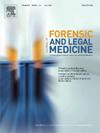牙本质厚度模型:利用全景放射摄影估算牙龄的新方法。
IF 1.2
4区 医学
Q3 MEDICINE, LEGAL
引用次数: 0
摘要
该研究旨在评估基于牙根参数的新型牙本质厚度模型在应用于土耳其南部亚群下颌第一磨牙全景放射摄影图像时的可靠性。研究共分析了 946 张全景图像。样本被分为四个年龄组:第一组(10 至 18 岁)、第二组(19 至 30 岁)、第三组(31 至 50 岁)、第四组(51 至 78 岁)。牙本质厚度模型测量包括远端牙根中侧的根部牙本质厚度和远端牙管宽度。统计采用回归分析、类内相关系数分析和杜宾-沃森分析。在牙本质厚度模型中检测到中等相关性(R = 0.398)。根牙本质厚度和根管宽度有显著影响(P 0.05)。第 3 组显示出最高的准确性(p本文章由计算机程序翻译,如有差异,请以英文原文为准。
Dentin thickness model: A novel method for dental age estimation using panoramic radiography
The study aims to evaluate the reliability of the novel dentin thickness model based on root parameters when applied to panoramic radiography images of mandibular first molar in the southern Turkish subpopulation. A total of 946 panoramic images were analyzed for the study. The samples were allocated into four age groups: Group 1(between 10 and 18), Group 2(between 19 and 30), Group 3(between 31 and 50), Group 4(between 51 and 78). The dentin thickness model measurements consisted of root dentin thickness of the mesial aspect of the distal root and distal canal width. Regression, intraclass correlation coefficient, and Durbin-Watson analyses were used for statistics. A medium correlation was detected in the dentin thickness model (R = 0.398). Root dentin thickness and canal width had a significant effect (p < 0.05), but gender did not (p > 0.05). Group 3 showed the highest accuracy (p < 0.001). Group 4 presented the lowest correlation with chronological age compared to other age groups (p < 0.001). The dentin thickness model showed a promising result for the dental age estimation with a medium correlation. The dentin thickness model included root measurements of the mesial aspect of the mandibular first molar without any crown parameters in the southern Turkish subpopulation. Gender did not affect the dentin thickness model.
求助全文
通过发布文献求助,成功后即可免费获取论文全文。
去求助
来源期刊

Journal of forensic and legal medicine
MEDICINE, LEGAL-
CiteScore
2.70
自引率
6.70%
发文量
106
审稿时长
57 days
期刊介绍:
The Journal of Forensic and Legal Medicine publishes topical articles on aspects of forensic and legal medicine. Specifically the Journal supports research that explores the medical principles of care and forensic assessment of individuals, whether adult or child, in contact with the judicial system. It is a fully peer-review hybrid journal with a broad international perspective.
The Journal accepts submissions of original research, review articles, and pertinent case studies, editorials, and commentaries in relevant areas of Forensic and Legal Medicine, Context of Practice, and Education and Training.
The Journal adheres to strict publication ethical guidelines, and actively supports a culture of inclusive and representative publication.
 求助内容:
求助内容: 应助结果提醒方式:
应助结果提醒方式:


